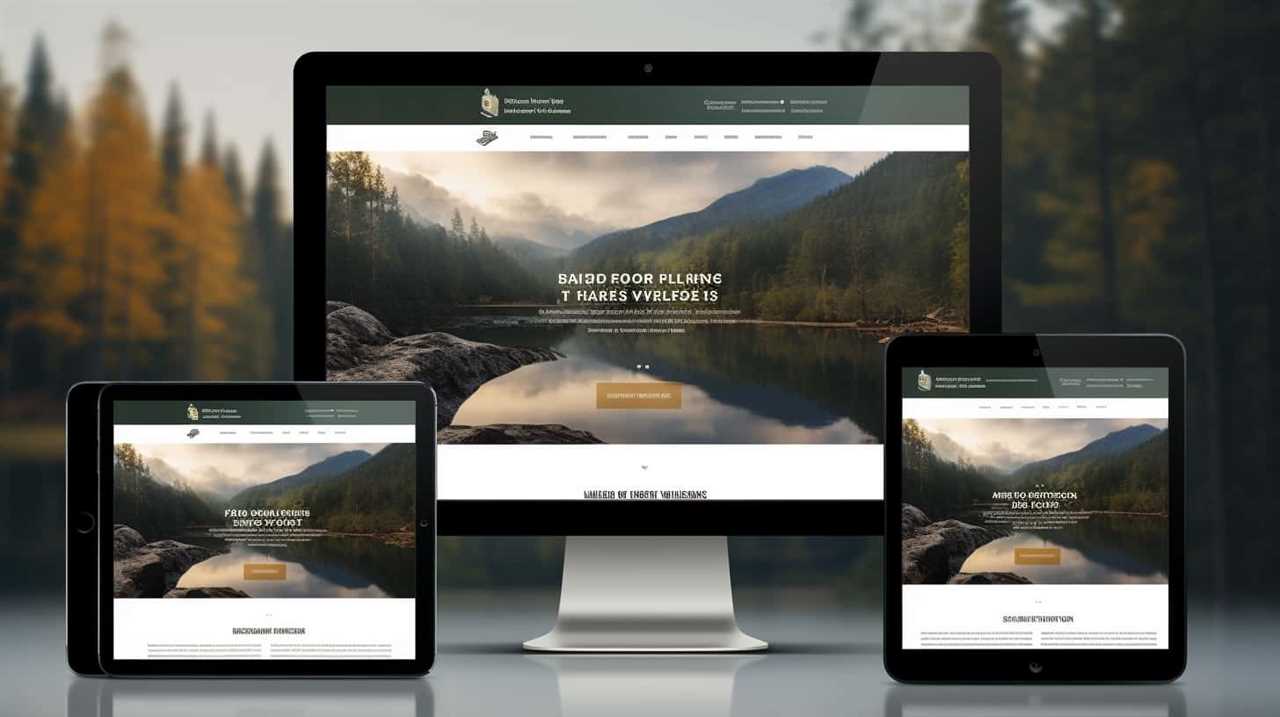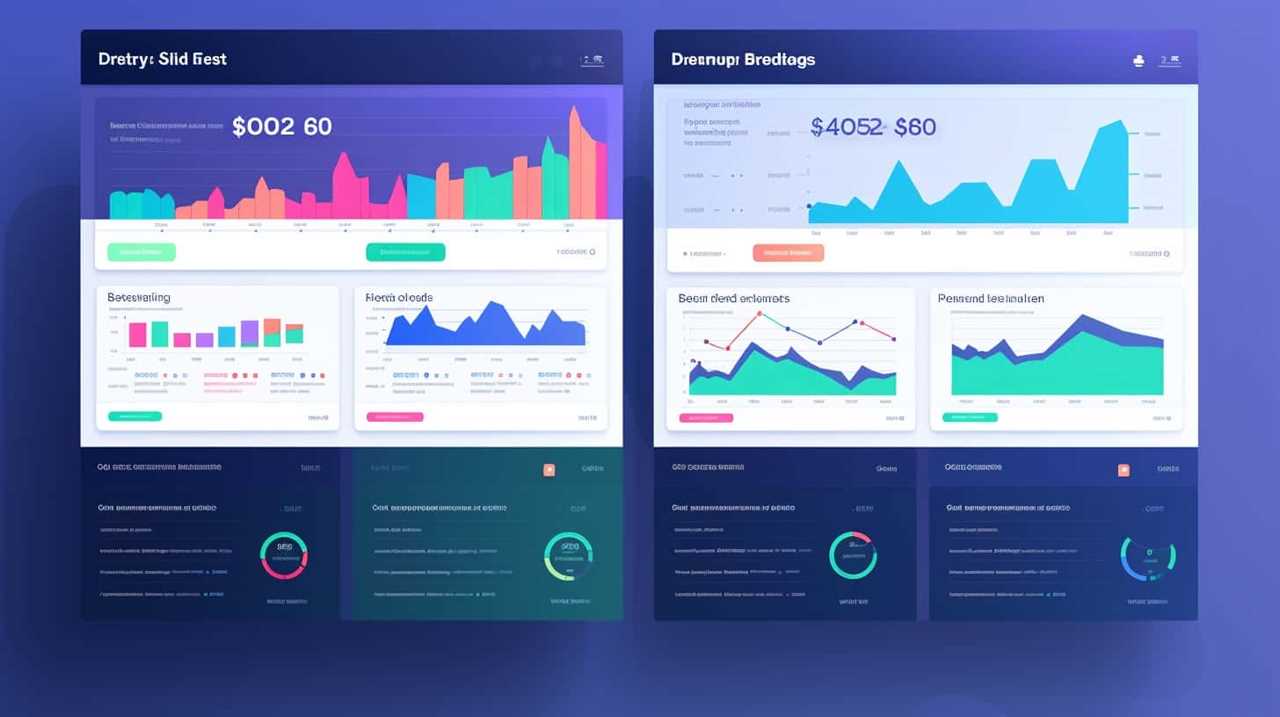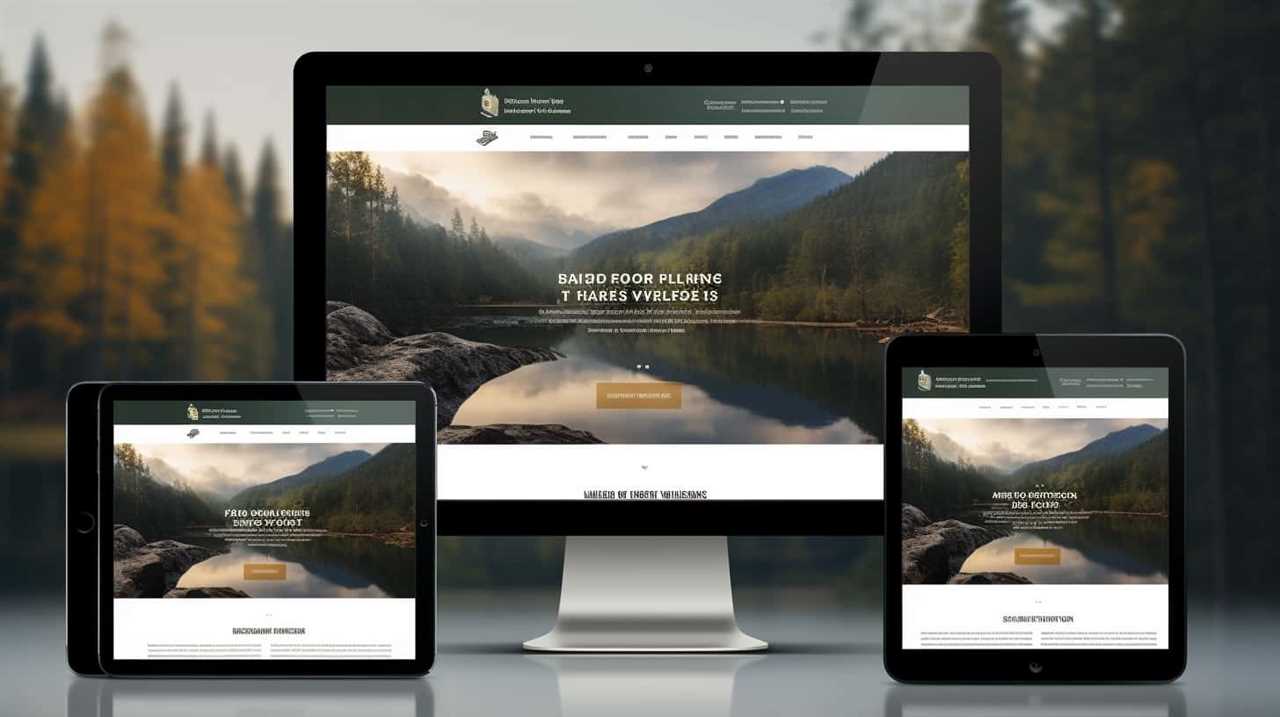Keyword Research
Mobile SEO: Services That Make Your Site Smartphone-Friendly

All of us have experienced the frustration of trying to navigate a website on our mobile devices, only to find it clunky and unresponsive.
But fear not, because mobile SEO services are here to save the day.
With responsive design, mobile-friendly layouts, and optimized loading speeds, your site will be smartphone-friendly and user-focused.
Say goodbye to lost customers and hello to a seamless mobile experience.

It’s time to master the art of mobile optimization.
Key Takeaways
- Mobile-friendly website design and optimization is crucial for providing an optimal viewing experience for users and increasing search engine visibility.
- Optimized page loading speed is essential for a mobile-friendly website, as it reduces data transfer, improves loading times, and enhances user experience.
- User-friendly navigation, including clear and intuitive menus, a sticky header, and a search bar, improves the overall mobile experience and enhances user engagement.
- Mobile SEO strategies, such as mobile-friendly content formatting, mobile-focused keyword research, local mobile SEO optimization, and voice search optimization, help optimize websites for mobile search and improve visibility.
Responsive Design
We offer several responsive design services that ensure our clients’ websites are optimized for smartphone usage.
Responsive design refers to designing websites that adapt and respond to different screen sizes and devices, providing an optimal viewing experience for users.
One of the challenges of responsive design is designing a layout that works well on both desktop and mobile devices, considering factors like screen size, touch navigation, and limited bandwidth.

However, the benefits of responsive design are significant. It improves user experience by eliminating the need for separate mobile and desktop websites, reduces maintenance and development costs, and increases search engine visibility.
By implementing responsive design, our clients can ensure that their websites are accessible and user-friendly on all devices.
Now, let’s delve into the next section about mobile-friendly website layout.
Mobile-Friendly Website Layout
Continuing from the previous subtopic of responsive design, we ensure that the website layout is mobile-friendly by considering factors such as screen size, touch navigation, and limited bandwidth.

Here are three key elements that contribute to a mobile-friendly website layout:
- Responsive design: This ensures that the website adapts seamlessly to different screen sizes, providing a consistent user experience across devices.
- Easy navigation: Mobile users often interact with websites using touchscreens, so it’s crucial to have a navigation system that’s easy to use and intuitive.
- Optimized content: Mobile site optimization involves optimizing images and other media files to reduce loading time and bandwidth usage, providing a smooth browsing experience for mobile users.
Optimized Page Loading Speed
We know how frustrating it can be when a website takes forever to load on a mobile device. That’s why optimizing page loading speed is crucial for a mobile-friendly website.
Accelerating Page Load Times
To improve the user experience on mobile devices, we can optimize page loading speed by focusing on accelerating page load times. Here are three essential strategies to achieve this:
- Minimize file sizes: Compressing images, CSS, and JavaScript files reduces the amount of data that needs to be transferred, resulting in faster loading times.
- Enable browser caching: By storing website files locally on a user’s device, subsequent visits to the site will load faster since the browser doesn’t need to download everything again.
- Optimize server response: Improving the performance of your server and reducing response times can significantly enhance the speed at which your pages load.
By implementing these techniques, you can ensure that your mobile website loads quickly and efficiently, providing a seamless experience for your users.

Now, let’s delve into the next section about mobile-friendly website performance.
Mobile-Friendly Website Performance
As we delve into the topic of mobile-friendly website performance, it is essential to prioritize optimized page loading speed. A mobile-friendly website design that loads quickly is crucial for providing a positive user experience and improving your mobile SEO. Slow loading times can frustrate users, leading to higher bounce rates and lower conversions. To emphasize the importance of page loading speed, let’s take a look at a comparison table showcasing the loading times of mobile-friendly websites before and after optimization:
| Website | Before Optimization | After Optimization |
|---|---|---|
| Website A | 7 seconds | 2 seconds |
| Website B | 10 seconds | 3 seconds |
| Website C | 5 seconds | 1 second |
| Website D | 8 seconds | 2 seconds |
User-Friendly Navigation
One key aspect of mobile SEO is implementing a clear and intuitive navigation system for users. A user-friendly navigation enhances user engagement and improves the overall mobile experience.
To achieve this, consider the following:

- Simplify the navigation menu: Keep the menu items concise and organized, making it easy for users to find what they’re looking for.
- Utilize a sticky header: A fixed header at the top of the screen ensures that the navigation menu is always accessible, even when scrolling through a long page.
- Implement a search bar: Including a search function allows users to quickly find specific content, enhancing their browsing experience.
Mobile-Friendly Content Formatting
When it comes to mobile-friendly content formatting, there are several important points to consider.
Firstly, responsive design is crucial to ensure that your website adapts seamlessly to different screen sizes and orientations.
Secondly, optimizing images for mobile is essential to minimize loading times and improve user experience.
Lastly, minimizing loading time overall is key to keeping users engaged and preventing them from bouncing off your site.

Responsive Design Importance
Responsive design plays a crucial role in ensuring that your website’s content is formatted to be mobile-friendly. Here are three reasons why responsive design is important for your website:
- Improved user experience: With responsive design, your website automatically adjusts to fit the screen size of the user’s device. This provides a seamless and consistent experience, making it easier for users to navigate and consume your content.
- Higher mobile SEO rankings: Responsive design is preferred by search engines, as it eliminates the need for separate mobile and desktop versions of your site. This means that your website is more likely to rank higher in mobile search results, leading to increased visibility and organic traffic.
- Increased conversion rates: Mobile users expect a fast and user-friendly experience. By implementing responsive design, you can ensure that your website loads quickly and provides a smooth browsing experience. This can lead to higher conversion rates and more satisfied customers.
Optimizing Images for Mobile
To optimize images for mobile, we focus on formatting the content to be mobile-friendly. Progressive enhancement is a key technique that ensures that images are displayed properly on different devices. By starting with a basic version of the image and then adding enhancements for more advanced devices, we can provide a consistent and optimized experience for all users.
Mobile image compression is another important aspect of optimizing images for mobile. By compressing images without sacrificing quality, we can reduce the file size and improve loading times on mobile devices. This is crucial for providing a seamless browsing experience and minimizing loading time, which we’ll discuss in the next section.
Minimizing Loading Time
We prioritize minimizing loading time by employing mobile-friendly content formatting techniques. By optimizing website speed, we ensure that users have a seamless and efficient browsing experience on their smartphones.

Here are three ways we improve website performance and reduce loading time:
- Compressing images: We use image compression techniques to reduce file sizes without compromising on quality. This allows for faster loading times without sacrificing visual appeal.
- Minimizing code: We optimize the website’s HTML, CSS, and JavaScript code to remove any unnecessary elements or redundant code. This helps reduce the amount of data that needs to be loaded, resulting in faster page rendering.
- Caching: We implement caching mechanisms to store frequently accessed data on the user’s device. This reduces the need for repeated server requests, leading to improved loading times.
Mobile-Focused Keyword Research
When conducting mobile-focused keyword research, our team analyzes specific terms and phrases that optimize your site’s visibility on smartphones. Mobile-focused keyword targeting is essential for optimizing your website for mobile search.
By understanding the keywords that users are searching for on mobile devices, we can ensure that your site appears prominently in mobile search results. Our team uses various tools and techniques to identify relevant keywords and phrases that are popular among mobile users. We also consider the specific context and intent behind mobile searches to create a comprehensive mobile keyword strategy.
Local Mobile SEO Optimization
When it comes to mobile SEO, targeting local audiences is crucial. By optimizing for local intent and boosting mobile search visibility, businesses can ensure that they’re reaching the right audience at the right time.

This means focusing on local keywords, creating location-specific content, and optimizing for local directories and maps.
Importance of Local Targeting
Local targeting is a crucial aspect of optimizing your website for mobile search, ensuring that it reaches the right audience in specific geographical areas. Here are three reasons why local targeting is so important:
- Increased visibility: By optimizing your website for local search, you can increase your visibility in local search results. This means that when someone in your target area searches for a product or service that you offer, your website is more likely to appear in their search results.
- Higher conversion rates: When your website is optimized for local search, you’re targeting an audience that’s more likely to convert into customers. People tend to trust businesses that are local to them, making them more likely to make a purchase or engage with your website.
- Enhanced online reputation: Local targeting allows you to build a strong online reputation within your community. By focusing on local citation and providing valuable content to your local audience, you can establish yourself as a trusted authority in your field.
Boosting Mobile Search Visibility
To further enhance our mobile search visibility, how can we optimize our website for local search?
Local mobile SEO optimization plays a crucial role in boosting our mobile search ranking and ensuring that our website is easily discoverable by users in our target location.

One important aspect of local mobile SEO optimization is to ensure that our website is optimized for mobile devices, as mobile search algorithms prioritize mobile-friendly sites. This includes using responsive design, optimizing page load speed, and ensuring that our content is easily readable on smaller screens.
Additionally, it’s essential to optimize our website for local keywords and phrases, such as including our location in page titles, headings, and content.
Optimizing for Local Intent
Our focus now turns to optimizing for local intent, a crucial aspect of local mobile SEO optimization. When it comes to local search optimization, geolocation targeting plays a vital role.
Here are three key strategies to implement for effective local mobile SEO optimization:

- Optimize your website for local keywords: Conduct thorough keyword research to identify relevant local search terms. Incorporate these keywords strategically throughout your website’s content, meta tags, and URLs to improve your chances of appearing in local search results.
- Claim and optimize your Google My Business listing: Ensure that your business information is accurate and up-to-date on your Google My Business profile. This will help Google understand the relevance of your business to local searches and improve your visibility in local search results.
- Encourage customer reviews and ratings: Positive reviews and ratings not only enhance your credibility but also boost your visibility in local search results. Encourage your satisfied customers to leave reviews and respond to them promptly and professionally.
Voice Search Optimization
One of the key aspects of optimizing a website for mobile devices is implementing voice search optimization. Voice search is becoming increasingly popular, with more and more users relying on their smartphones to perform searches using their voice. To stay ahead in the ever-changing landscape of SEO, it’s crucial to understand voice search trends and implement effective voice search optimization strategies.
When it comes to voice search optimization, there are several strategies to consider. First, it’s important to optimize your website for conversational queries, as users tend to use more natural language when speaking. Additionally, optimizing for featured snippets can help increase your chances of appearing in voice search results. Finally, ensuring that your website loads quickly and is mobile-friendly is essential for a seamless voice search experience.
Now that we’ve covered voice search optimization, let’s move on to the next topic: mobile-friendly image optimization.
Mobile-Friendly Image Optimization
As we delve into mobile-friendly image optimization, it’s important to consider the impact of high-quality visuals on the overall user experience. To ensure your images are mobile-friendly, here are three key techniques to implement:

- Mobile-friendly image compression: Compress your images without compromising their quality to reduce file size and improve loading speed. This enhances the user experience by minimizing wait times and reducing data usage.
- Mobile-friendly image alt tags: Add descriptive alt tags to your images that accurately describe their content. This not only helps visually impaired users understand the image but also improves search engine optimization by providing context to crawlers.
- Responsive image design: Implement responsive design techniques to automatically adjust the size and resolution of images based on the user’s device. This ensures that your images look great on any screen size, providing a seamless and visually appealing experience.
Mobile-Specific Meta Tags
To optimize your website for mobile devices, we need to consider the implementation of mobile-specific meta tags. These tags provide information to search engines about the mobile version of your site, helping them understand and index your content properly.
Mobile-specific meta tags play a crucial role in mobile SEO strategies, as they allow search engines to differentiate between desktop and mobile versions of your site. By including these tags, you can ensure that your mobile site is optimized for search engine visibility and ranking.
Additionally, mobile-specific meta tags can also help in optimizing mobile site speed by providing information about the viewport and enabling browser caching. With the implementation of mobile-specific meta tags, you can enhance the overall mobile user experience and improve your site’s performance on mobile devices.
Now, let’s move on to the next section and explore the importance of app indexing and deep linking.

App Indexing and Deep Linking
App indexing and deep linking are essential services for optimizing your mobile site and improving the user experience. Here are three reasons why you should consider implementing these strategies:
- Enhanced app discovery: By indexing your app content, search engines can crawl and rank it, making it easier for users to find your app in search results. This increases your app’s visibility and drives more downloads.
- Seamless navigation: Deep linking allows users to navigate directly to specific content within your app from search results or other external sources. This improves the user experience by eliminating the need to search for desired information manually.
- Increased mobile app engagement: Deep linking also enables you to re-engage users by directing them to relevant content or specific features within your app. This personalized approach increases user satisfaction and encourages them to spend more time on your app.
Mobile-Friendly Call-To-Action Buttons
Now let’s delve into the topic of mobile-friendly call-to-action buttons, a crucial aspect of optimizing your mobile site and improving the user experience.
Mobile-friendly call-to-action buttons, also known as mobile CTAs, play a vital role in mobile friendly conversion optimization. These buttons are designed to be easily clickable and visible on smaller screens, ensuring that users can easily take action on your mobile site.
To create effective mobile CTAs, it’s important to consider their placement, size, and design. Placing the buttons in a prominent location, using a size that’s easy to tap, and employing contrasting colors can help increase conversion rates.

Accelerated Mobile Pages (Amp) Implementation
Now, let’s talk about the implementation of Accelerated Mobile Pages (Amp) and the benefits it brings to SEO.
Amp is a framework that allows for faster loading times and improved user experience on mobile devices. It provides a lightweight version of your webpages, optimized for speed and performance.
When compared to responsive design, Amp offers a different approach to mobile optimization, and implementing Amp best practices can greatly enhance your site’s mobile-friendliness.
Amp Benefits for SEO
We frequently utilize Amp implementation to enhance the SEO performance of our mobile websites. Implementing Amp has several benefits for SEO that can significantly improve the visibility and ranking of your mobile site.

Here are three key advantages of Amp for SEO:
- Faster Page Load Times: Amp pages are designed to load instantly, providing a seamless user experience. This faster load time not only improves user satisfaction but also positively impacts your site’s SEO ranking, as page speed is a crucial factor in mobile search engine optimization strategy.
- Improved Mobile Rankings: Google prioritizes mobile-friendly websites in its search results. By implementing Amp, you can ensure that your site is optimized for mobile devices, leading to higher rankings and increased organic traffic.
- Enhanced User Engagement: Amp pages are designed to be user-focused and provide a smooth browsing experience. This leads to increased user engagement and longer session durations, which are important metrics for SEO.
Amp Vs Responsive Design
Implementing Amp can have significant advantages over responsive design when it comes to optimizing your site for mobile devices. Amp, or Accelerated Mobile Pages, is a framework that allows for faster loading times and improved user experience on mobile devices. While responsive design is a popular approach for making websites mobile-friendly, Amp takes it a step further by focusing on speed and performance.
To better understand the differences between Amp and responsive design, let’s compare them in a table:
| Amp | Responsive Design |
|---|---|
| Faster loading times | Adapts to all screen sizes |
| Improved user experience | More flexibility in design |
| Simplified HTML structure | Requires more development time |
When it comes to Amp vs native apps, Amp offers the advantage of being accessible through a web browser without the need for users to download and install an app. This can save time and effort for both users and developers. Additionally, Amp is designed with mobile SEO in mind, ensuring that your site is optimized for mobile search and ranking higher in mobile search results compared to desktop SEO.

In the next section, we will explore best practices for Amp implementation to ensure the best possible results for your mobile-friendly site.
Amp Implementation Best Practices
To ensure the best results for your mobile-friendly site, it’s important to implement Amp (Accelerated Mobile Pages) using best practices. When implementing Amp, there are a few challenges to consider, but with the right approach, you can overcome them and optimize your website’s performance.
Here are some best practices for Amp implementation:
- Minimize JavaScript: Amp requires you to minimize the use of JavaScript to improve page loading speed and overall performance. By reducing the reliance on JavaScript, you can ensure a smoother user experience.
- Optimize Images: Images play a crucial role in mobile browsing, but they can also slow down your website. Optimize your images by compressing them and using the appropriate format to reduce file size without sacrificing quality.
- Use Inline CSS: Instead of external CSS files, use inline CSS to reduce the number of HTTP requests and improve page loading speed. This will help enhance the performance of your Amp pages.
Implementing Amp can have a significant impact on your website’s performance, but by following these best practices, you can overcome challenges and create a seamless mobile experience for your users.

Mobile-Friendly Forms and Contact Information
When optimizing your website for smartphones, it is essential to ensure that your forms and contact information are mobile-friendly. Mobile friendly form design allows users to easily input information and submit forms on their smartphones without any hassle. Contact information optimization ensures that your phone number, email address, and physical address are displayed prominently and are easy to find and use on a mobile device.
| Mobile Friendly Form Design | Contact Information Optimization |
|---|---|
| Simplify form fields and use dropdown menus or checkboxes whenever possible | Display your phone number prominently on your mobile website |
| Use clear and concise labels for each form field | Make sure your email address is clickable and opens the user’s default email app |
| Implement auto-fill options to make it easier for users to input information | Include your physical address and link it to a map for easy navigation |
Mobile Analytics and Tracking
We can track and analyze mobile user behavior by using mobile analytics and tracking tools. These tools provide valuable insights into how users interact with our mobile website or app, allowing us to optimize our mobile advertising effectiveness and improve our mobile conversion rate.
Here are three key benefits of using mobile analytics and tracking:
- Understand user behavior: By monitoring user actions, such as clicks, swipes, and time spent on each page, we gain a deeper understanding of how users navigate our mobile site. This information helps us identify any pain points or areas for improvement.
- Measure campaign success: Mobile analytics allow us to track the performance of our mobile advertising campaigns. We can monitor metrics like click-through rates, conversions, and return on investment to gauge the effectiveness of our mobile marketing efforts.
- Optimize user experience: By analyzing user behavior, we can identify opportunities to enhance the mobile user experience. This may involve making design changes, improving page load times, or streamlining the checkout process to increase conversions.
Using mobile analytics and tracking tools empowers us to make data-driven decisions to improve our mobile presence and ultimately drive better results.

Frequently Asked Questions
How Can I Optimize My Website for Voice Search?
We optimize our website for voice search by staying up-to-date with mobile SEO trends. By incorporating voice search optimization techniques, we ensure our site is easily accessible and user-friendly for those using voice commands.
What Are Some Best Practices for Mobile-Friendly Image Optimization?
When it comes to mobile-friendly image optimization, we focus on responsive design and mobile-first indexing. By optimizing images for different screen sizes and using proper compression techniques, we enhance user experience and site performance.
How Can I Ensure That My Website Is Optimized for Local Mobile Seo?
To ensure our website is optimized for local mobile SEO, we implement various strategies such as optimizing our content for local keywords, creating mobile-friendly layouts, and improving page load speed for better user experience.
What Are Mobile-Specific Meta Tags and How Do They Impact Seo?
Mobile-specific meta tags play a crucial role in mobile SEO optimization. These tags provide information to search engines about how your site should be displayed on mobile devices, impacting your site’s visibility and ranking.

What Is the Significance of AMP Implementation for Mobile Seo?
The significance of amp implementation for mobile SEO lies in the benefits it provides for both user experience and SEO. It improves page load speed, enhances mobile usability, and positively impacts search engine rankings.
Conclusion
In conclusion, ensuring that your website is mobile-friendly is essential in today’s digital landscape. By implementing responsive design, optimizing page loading speed, and creating user-friendly navigation, you can provide a seamless experience for smartphone users.
Don’t let your site fall behind – embrace the mobile revolution and reap the benefits of increased traffic and engagement. Remember, a stitch in time saves nine, so invest in mobile SEO now and stay ahead of the competition.
Keyword Research
How to Do Keyword Research on Semrush

Are you prepared to become an expert in keyword research using Semrush? We’ve got all the resources you need!
In this article, we’ll guide you through the process of setting up your Semrush account.
We’ll also help you understand its powerful keyword research features and how to conduct initial research.
Additionally, we’ll show you how to analyze keyword metrics and competition, refine your keyword list, and implement your findings.

Get ready to take your SEO strategy to the next level with Semrush!
Key Takeaways
- Sign up for a Semrush account and set up your website details
- Connect your Google Analytics and Google Search Console accounts to Semrush
- Utilize Semrush’s keyword research tools for content optimization and focus on long tail keywords
- Analyze competitors’ keyword strategies to refine your own approach and gain a competitive edge
Setting up Your Semrush Account
First, we’ll guide you through the process of setting up our Semrush account.
When exploring Semrush’s account management features, it’s crucial to understand how to maximize the benefits of its keyword tracking capabilities.
Setting up your Semrush account is a straightforward process. After signing up, you’ll be prompted to enter your website’s details and connect your Google Analytics and Google Search Console accounts. This allows Semrush to gather data about your website’s performance and keywords.

Once you’ve completed these steps, you can start exploring Semrush’s account management features, such as tracking your organic search positions, monitoring your competitors, and analyzing your website’s overall visibility.
Understanding Semrush’s account management features will lay the foundation for effectively utilizing its keyword tracking capabilities in the subsequent section about ‘Understanding Semrush’s Keyword Research Features’.
Understanding Semrush’s Keyword Research Features
Continuing our exploration of Semrush’s account management features, let’s delve into understanding Semrush’s keyword research capabilities.
When it comes to optimizing your content for search engines, Semrush’s keyword research tools are invaluable. Here are three key features to help you make the most of your keyword research:

- Content optimization: Semrush’s keyword research tools provide insights into the keywords your target audience is searching for. This allows you to optimize your content to align with their search intent and increase your chances of ranking higher in search engine results pages.
- Long tail keywords: Semrush’s keyword research emphasizes the importance of long tail keywords. These longer and more specific phrases have lower competition and higher conversion rates, making them a crucial element in your SEO strategy.
- Competitor analysis: Semrush’s keyword research allows you to analyze your competitors’ keyword strategies. By identifying the keywords they’re targeting, you can gain valuable insights and refine your own keyword strategy to outperform them.
Understanding and leveraging Semrush’s keyword research tools will give you a competitive edge in optimizing your content and driving organic traffic to your website.
Conducting Initial Keyword Research
Now, let’s delve into how we can conduct our initial keyword research on Semrush.
When it comes to finding relevant keywords, there are a few effective strategies we can employ. One of them is focusing on long tail keywords, which are more specific and have lower competition. By targeting these keywords, we can attract highly targeted traffic to our website.
Additionally, utilizing competitor analysis for keyword research can provide valuable insights into the keywords that are driving traffic to our competitors’ websites. This information can help us identify untapped opportunities and optimize our own content.

By employing these strategies, we can lay the foundation for a successful keyword research campaign.
In the next section, we’ll discuss how to analyze keyword metrics and competition to further refine our keyword selection and strategy.
Analyzing Keyword Metrics and Competition
To further refine our keyword selection and strategy, we can analyze keyword metrics and competition on Semrush. This step is crucial in choosing the right keywords for your SEO strategy.
By analyzing keyword difficulty and search volume, we can better target our audience and increase our chances of ranking higher in search engine results.

Here are three key factors to consider when analyzing keyword metrics and competition:
- Keyword Difficulty: This metric helps us understand how challenging it will be to rank for a specific keyword. A higher difficulty score indicates stronger competition, while a lower score suggests a better chance of ranking.
- Search Volume: This metric shows how many people are searching for a particular keyword. It helps us identify popular keywords with a higher potential for driving traffic to our website.
- Competitor Analysis: By examining the competition for our chosen keywords, we can gain insights into their strategies, strengths, and weaknesses. This information allows us to refine our own approach and find gaps in the market.
Analyzing these metrics and competition will help us make informed decisions about the keywords to target, ultimately improving our SEO strategy.
Refining Your Keyword List and Implementing Your Findings
After analyzing keyword metrics and competition on Semrush, we refine our keyword list and implement our findings.
Refining our keyword list involves removing irrelevant keywords and focusing on those with high potential for driving organic traffic. We also identify long-tail keywords, which have lower competition and higher conversion rates.

Implementing keyword optimization strategies is crucial for maximizing organic traffic growth. This includes incorporating targeted keywords into website content, meta tags, and URLs. It’s also important to optimize on-page elements such as headings, image alt tags, and internal links.
Additionally, monitoring keyword rankings and making necessary adjustments is essential for staying ahead of the competition.
Frequently Asked Questions
Can I Use Semrush for Keyword Research on Platforms Other Than Google?
Yes, you can use Semrush for keyword research on social media platforms and e-commerce platforms. It provides valuable insights and data to help you optimize your keyword strategy across different platforms.
How Often Should I Update My Keyword List?
We update our keyword list regularly to ensure we stay up to date with search trends and maximize the benefits of our research. The frequency of updating the keyword list depends on the dynamic nature of our industry.

Can I Track the Performance of My Keywords Over Time?
Yes, we can track the performance of our keywords over time. It is important to track keyword rankings to understand how our SEO efforts are impacting search visibility and to make informed optimization decisions.
Are There Any Alternative Tools to Semrush for Keyword Research?
There are several alternative keyword research tools available that can be used for keyword research. It is important to compare these tools and consider their pros and cons before making a decision.
How Can I Find Long-Tail Keywords Using Semrush?
Finding long-tail keywords on Semrush helps us unlock the benefits of using them in SEO. By optimizing our content with these specific keywords, we can attract targeted traffic and improve our search rankings. Here are some tips for optimizing content with long-tail keywords.
Conclusion
In conclusion, conducting keyword research on Semrush is crucial for optimizing your website’s visibility and driving organic traffic.

By setting up your account, exploring the platform’s features, and analyzing keyword metrics and competition, you can refine your keyword list and implement effective strategies.
Remember, success lies in finding the right keywords that resonate with your target audience and align with your business goals.
So, start your research journey on Semrush and unlock the potential for online success.
Keyword Research
How to Do Keyword Research With Google

In our pursuit of digital dominance, grasping the significance of keywords is crucial. These concise yet powerful words are essential for online achievement. So, what’s the optimal way to take advantage of this opportunity?
Fear not, for we have Google by our side. With its Keyword Planner, we can uncover valuable keyword ideas. And with Google Trends, we can analyze competition.
Together, let’s embark on a journey of keyword research using the tools at our disposal.
Key Takeaways
- Keyword research helps identify relevant and high-performing keywords for a website.
- Long tail keywords target specific niche markets and attract a focused audience.
- Google Keyword Planner provides comprehensive keyword suggestions based on search volume, competition, and relevance.
- Google Trends provides insights on search volume and keyword trends over time.
Understanding the Importance of Keyword Research
Keyword research is an essential step in our digital marketing strategy as it helps us identify the most relevant and high-performing keywords for our website.

One of the benefits of long tail keywords in keyword research is their ability to target specific niche markets. By including more specific and descriptive phrases in our content, we can attract a more focused audience that’s more likely to convert.
Additionally, long tail keywords often have less competition, making it easier for our website to rank higher in search engine results.
Another crucial aspect of keyword research is understanding keyword intent. By analyzing the intent behind a user’s search query, we can optimize our website and content to align with their needs and preferences.
This not only improves our search engine rankings but also increases the chances of attracting qualified traffic to our website.

Using Google Keyword Planner for Keyword Ideas
We frequently rely on Google Keyword Planner to generate a multitude of keyword ideas for our digital marketing strategy. Here’s why it’s our go-to tool:
- Comprehensive keyword suggestions:
Google Keyword Planner provides a vast array of keyword ideas based on search volume, competition, and relevance. This allows us to explore a wide range of options and identify the most effective keywords for our campaigns. - Comparison with other tools:
One of the key advantages of Google Keyword Planner is its ability to compare keyword data with other tools. This feature helps us gain valuable insights and make informed decisions when selecting the right keywords for our targeting. - Long tail keyword targeting:
Google Keyword Planner also helps us identify long tail keywords, which are specific and highly targeted phrases. Using long tail keywords allows us to reach a more niche audience, resulting in better conversion rates and higher ROI.
Analyzing Keyword Competition With Google Trends
To assess keyword competition, we turn to Google Trends for valuable insights and data-driven analysis. Google Trends allows us to analyze search volume and identify keyword trends over time.
By entering a keyword or a group of keywords into Google Trends, we can see how their popularity has changed over the years and even compare different keywords to see which one is more popular. This information helps us understand the level of competition for a particular keyword and make informed decisions in our keyword research.
Utilizing Google Search Console for Keyword Insights
By leveraging the insights provided by Google Trends, we can now delve into the benefits of utilizing Google Search Console for valuable keyword insights.

Here are three key reasons why Google Search Console is an essential tool for advanced keyword research techniques:
- Performance Data: Google Search Console provides detailed performance data for your website, including the keywords that are driving organic traffic. This data allows you to identify high-performing keywords and optimize your content accordingly.
- Search Queries: With Google Search Console, you can see the exact search queries that users are entering to find your website. This information helps you understand user intent and refine your keyword targeting.
- Click-Through Rate (CTR) Analysis: Google Search Console provides CTR data for your website’s organic search results. By analyzing your CTR for different keywords, you can identify opportunities to improve your meta tags and increase your organic click-through rate.
Best Practices for Conducting Keyword Research With Google
Now let’s explore the best practices for conducting keyword research with Google and how it can enhance our understanding of user intent and drive organic traffic to our website.
When it comes to keyword research strategies for small businesses, it’s important to start by identifying relevant keywords that align with your target audience and business goals. Use tools like Google Keyword Planner or other keyword research tools to find high-volume, low-competition keywords.
Once you have a list of keywords, incorporate them strategically into your website content. Tips for optimizing website content with targeted keywords include placing them in the page title, meta description, headings, and throughout the body of the content. Remember to write naturally and provide valuable information to the users.

Regularly analyze and update your keyword strategy to stay ahead of the competition and drive more organic traffic to your website.
Frequently Asked Questions
How Can I Use Keyword Research to Improve My Website’s Search Engine Rankings?
To improve our website’s search engine rankings, we can use keyword research to optimize our content and implement the findings for on-page SEO improvements. It’s crucial for mastering search engine optimization.
Are There Any Alternative Tools or Platforms I Can Use for Keyword Research Besides Google Keyword Planner?
There are several alternative keyword research tools and platforms available, which can provide additional benefits when used alongside Google Keyword Planner. Using multiple tools allows for comprehensive and thorough keyword research.
Can I Use Google Trends to Analyze the Competition for Long-Tail Keywords?
Using Google Trends for competitor analysis is a great way to find profitable long-tail keywords. It allows us to see the popularity and seasonality of keywords, helping us make data-driven decisions for our keyword research.

How Can I Leverage the Data From Google Search Console to Enhance My Keyword Research Strategy?
To optimize our keyword research strategy, we can leverage the data from Google Search Console. It provides valuable insights into search queries, impressions, and CTR, helping us identify high-performing keywords and improve our content.
Are There Any Common Mistakes to Avoid When Conducting Keyword Research Using Google?
When it comes to keyword research, we’ve all made mistakes. But fear not! We’ll show you how to avoid common pitfalls and master the art of keyword research. Let’s dive in!
Conclusion
In the vast forest of online content, keyword research acts as our compass, guiding us to the hidden treasures of search engine visibility. Just as explorers rely on maps to navigate uncharted territories, we rely on Google’s tools to uncover valuable keywords.
With the power of Google Keyword Planner, Google Trends, and Google Search Console, we can analyze competition, gain insights, and optimize our content for success.

So, let’s embark on this digital quest armed with knowledge and make our mark in the online realm.
Keyword Research
How to Do Keyword Research

The advantages of incorporating long-tail keywords into content marketing approaches.
Are you ready to unlock the secrets of successful keyword research? We’ve got you covered.
In this article, we’ll guide you through the process step by step, helping you uncover the most valuable keywords for your target audience.
From brainstorming ideas to analyzing competition, we’ll show you how to refine your keyword list for maximum impact.

Get ready to take your SEO strategy to the next level and dominate the search engine rankings.
Let’s dive in and master keyword research together.
Key Takeaways
- Keyword research helps understand the language and phrases used by the target audience.
- Focusing on long tail keywords attracts more qualified traffic.
- Local SEO allows targeting customers in specific geographical areas.
- Keyword research helps identify popular search terms.
Understanding the Importance of Keyword Research
Keyword research is crucial for our online success. It helps us understand the language and phrases our target audience uses when searching for information, products, or services online. Two important aspects of keyword research are the role of long tail keywords and the impact of local SEO.
Long tail keywords play a significant role in keyword research. These are longer, more specific phrases that are less competitive but highly targeted. By focusing on long tail keywords, we can attract more qualified traffic to our website, increasing the chances of conversion.

Local SEO also has a profound impact on keyword research. Optimizing our website for local search helps us target customers in specific geographical areas. It allows us to tailor our keywords to include location-specific terms, making it easier for local customers to find us.
Understanding the importance of long tail keywords and the impact of local SEO is essential for effective keyword research and ultimately, our online success.
Defining Your Target Audience and Goals
To effectively conduct keyword research, we must first define our target audience and establish our goals. Understanding your audience’s search intent is crucial in identifying the keywords they’re likely to use when searching online. This will help us create content that aligns with their needs and interests. Additionally, setting realistic goals is essential to measure the success of our keyword research efforts.
Here are four steps to help us define our target audience and goals:

- Conduct market research to identify our target audience’s demographics, interests, and online behavior.
- Analyze competitor websites and social media platforms to understand what keywords they’re targeting.
- Use tools like Google Analytics and social media analytics to gain insights into our audience’s search queries and engagement patterns.
- Clearly define our goals, whether it’s increasing website traffic, generating leads, or improving search engine rankings.
Generating Keyword Ideas
Now that we’ve defined our target audience and established our goals, let’s dive into generating keyword ideas.
Brainstorming techniques are a great way to come up with a wide range of keywords that could potentially attract our target audience. A brainstorming session can involve listing related terms, thinking about different aspects of our product or service, and considering the pain points or needs of our audience.
Additionally, conducting niche keyword research can help us identify specific keywords that are relevant to our industry or market segment. By focusing on these niche keywords, we can narrow down our keyword list to be more targeted and effective.
In the next section, we’ll discuss how to analyze keyword competition and volume, which will further refine our keyword selection process.

Analyzing Keyword Competition and Volume
Now, let’s delve into how we analyze the competition and volume of keywords to further refine our keyword selection process.
To effectively analyze keyword competition and volume, we follow these steps:
- Analyzing keyword trends: We examine the search trends of specific keywords to understand their popularity over time. This helps us identify which keywords are currently in demand and can guide our content creation strategy.
- Identifying high-value keywords: We look for keywords with a high search volume and low competition. These keywords have the potential to drive significant traffic to our website and attract more potential customers.
- Competitor analysis: We analyze the keywords that our competitors are targeting. This gives us insights into their keyword strategy and helps us identify opportunities to outperform them in search engine rankings.
- Keyword difficulty assessment: We evaluate the difficulty of ranking for specific keywords by considering factors such as domain authority, backlink profile, and content quality of the top-ranking pages. This helps us prioritize our keyword targeting efforts.
Refining Your Keyword List for Maximum Impact
After analyzing keyword competition and volume, we can now focus on refining our keyword list for maximum impact. Keyword optimization techniques are essential to ensure that our website ranks higher in search engine results and attracts relevant traffic.
One effective strategy is to use long tail keywords effectively. These are longer and more specific phrases that target niche audiences and have lower competition. By incorporating long tail keywords into our content, we can attract more qualified leads and increase conversion rates.

Additionally, refining our keyword list allows us to prioritize the most relevant and high-performing keywords. This helps us create targeted and compelling content that resonates with our audience and improves our overall SEO strategy.
Frequently Asked Questions
How Can I Determine the Search Volume and Competition for Specific Keywords?
To determine search volume and competition for specific keywords, we use search volume determination and competition analysis. It helps us understand the popularity and competitiveness of keywords, allowing us to make informed decisions for our keyword research strategy.
Are There Any Tools Available to Help With Keyword Research?
There are various tools available to assist with keyword research. These tools can provide valuable insights into search volume and competition, allowing us to optimize our content effectively. Using the best practices for keyword research is crucial for success.
How Do I Identify Long-Tail Keywords and Why Are They Important?
Identifying long-tail keywords is crucial for effective SEO. They are specific, less competitive, and have a higher conversion rate. Incorporating long-tail keywords in content marketing strategies improves search visibility and drives targeted traffic to your website.

Can I Use Competitor Analysis to Improve My Keyword Research?
Yes, competitor analysis can greatly enhance our keyword research. By analyzing our competitors, we can uncover untapped keyword opportunities and leverage their keyword data to create strategic and engaging content.
What Is the Significance of Local Keyword Targeting and How Can I Incorporate It Into My Research?
Local keyword targeting is crucial for optimizing our website for local search. Incorporating local SEO in keyword research helps us reach a targeted audience and improve our visibility in specific geographic areas.
Conclusion
In conclusion, conducting effective keyword research is crucial for achieving maximum impact in your online presence.
By understanding the importance of keyword research and defining your target audience and goals, you can generate relevant keyword ideas.

Analyzing keyword competition and volume helps you refine your keyword list strategically.
Remember, the key to success lies in finding the right keywords that resonate with your audience and drive organic traffic to your website.
So, stay strategic and start your keyword journey today!
-

 Expert Content Authority2 weeks ago
Expert Content Authority2 weeks agoThe Pillar of SEO: Why Content Consistency Matters Most
-

 Learning Center2 weeks ago
Learning Center2 weeks agoUncover How To Use ChatGPT to Write Effective Ad Copy
-

 Learning Center1 week ago
Learning Center1 week agoAI in 2024: 10 Things We are NOT Looking Forward To
-

 Holistic SEO3 weeks ago
Holistic SEO3 weeks agoHolistic Local SEO Tactics for Small Businesses
-

 Learning Center2 weeks ago
Learning Center2 weeks agoOptimize Your Digital Experience with Akamai CDN
-

 Learning Center3 weeks ago
Learning Center3 weeks agoExperience How GPT-4 Turbo Beats Claude 2: A Review
-

 Learning Center3 weeks ago
Learning Center3 weeks agoMastering SEO through the Google SGE Lens: A Comprehensive Guide
-

 Holistic SEO2 weeks ago
Holistic SEO2 weeks agoMaximize Engagement with YouTube Videos End Screens














